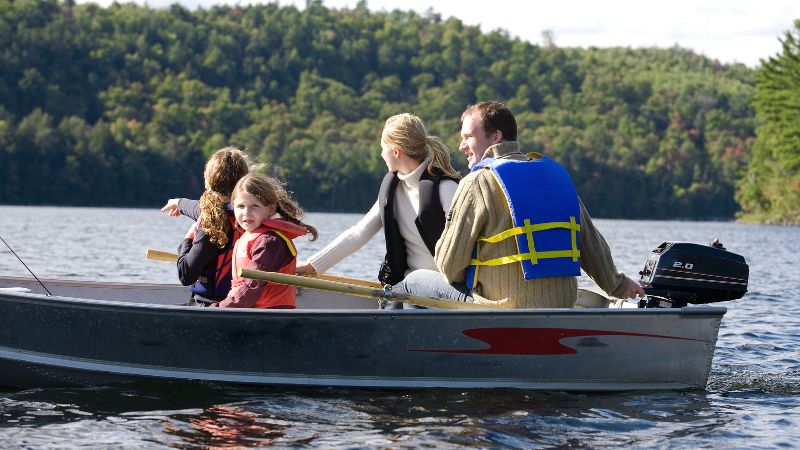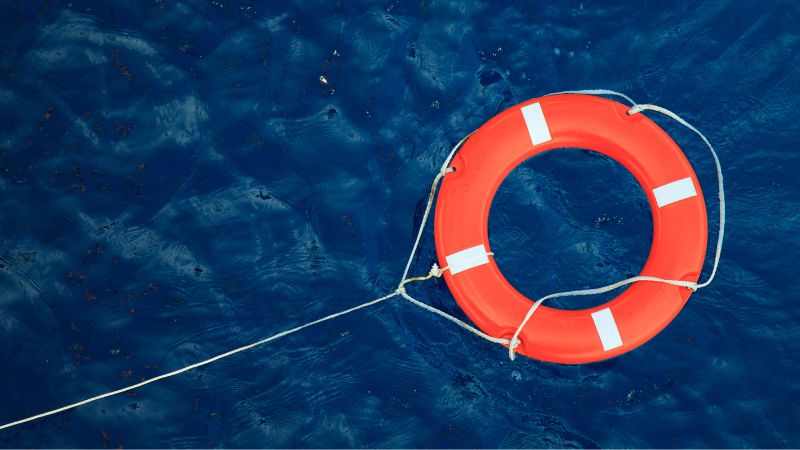Boating Test Prep: A passenger on a small boat falls overboard. how should this person be pulled back onto the boat?
If you’re preparing for your boat licensing test, one important thing that you will have to know regarding boat safety is understanding what to do if a passenger falls overboard.
One question commonly seen on boating tests goes over what to do if a passenger on a small boat falls overboard and how should this person be pulled back onto the boat.
The correct answer to this question and the most important things to do in a situation where a passenger falls overboard are:
1. Reduce Speed: Immediately decrease your speed and throw the victim a lifejacket or PFD, unless you are certain they are already wearing one.
2. Maneuver Safely: Turn your pleasure craft around and approach the victim slowly, pulling alongside them. Approach from downwind or into the current, whichever is stronger, to maintain control.
3. Stop the Engine: Shut off the engine to eliminate the risk of propeller injury to the person in the water.
4. Use Reaching Assist: Deploy a reaching assist, such as a buoyant heaving line or lifebuoy, to pull the victim to the side of the pleasure craft safely.
5. Employ a Reboarding Device: If available, use a reboarding device to aid the victim in getting back onto the pleasure craft. Alternatively, if a reboarding device is not accessible, carefully pull the victim onboard over the stern, ensuring to maintain balanced weight distribution in the pleasure craft, particularly in smaller boats.
By following these steps, you can effectively respond to a person overboard situation on your pleasure craft, prioritizing the safety and well-being of everyone on board.
Below are some other important questions that you should know the answers to regarding this same boating test topic:
Table of Contents
- What should you do first when a passenger on your boat falls overboard?
- How do you pull someone into a boat?
- How should passengers be pulled back in when they fall overboard?
- How should you move about in a small boat to avoid falling overboard?
- When operating a boat during a person overboard rescue, how should you position the boat?
- Where should you always step when boarding a small boat?
- What should you do if your small open boat capsizes?
- A passenger on a small boat falls overboard how should this person be pulled back onto the boat
- A passenger on your boat falls overboard. What should you do first?
- Falling overboard is a major risk on small boats. How can you reduce this risk?
- How should you move in a boat to avoid falling overboard
- How should you pull someone out of the water and into a small boat
- What should you always do when a person falls overboard?
- XXXXXXXXXXXXXX
- Why is knowing boat safety essential before going out on the water?
- Tips for preparing for your boating test:
- Check out our other study guides for boating test questions
- Getting Certified: Passing your boat exam

What should you do first when a passenger on your boat falls overboard?
When a passenger falls overboard from a boat, the first action to take is to stop the boat immediately. This prevents the vessel from moving away from the person in the water and ensures their safety remains the top priority. Once the boat is stopped, you can then proceed with the necessary rescue procedures to retrieve the passenger safely back on board.
How do you pull someone into a boat?
To safely pull someone into a boat, it’s crucial to approach them with care and attention. Extend a sturdy object, such as a rope or lifebuoy, for the person to grasp onto, maintaining clear communication throughout the rescue process. Assist them by grabbing onto their clothing or a secure part of their body while ensuring stability and balance. Once within reach, securely bring them aboard and assess their condition for any injuries or distress, providing necessary first aid. Prioritize the safety of both the rescuer and the person rescued, implementing preventive measures for future incidents.
How should passengers be pulled back in when they fall overboard?
When passengers fall overboard, they should be pulled back into the boat using a systematic approach to ensure safety and efficiency. First, the boat should reduce speed and approach the victim from downwind or into the current, whichever is stronger. Then, a lifejacket or personal flotation device (PFD) should be tossed to the victim if they are not already wearing one. Next, the boat should slowly pull alongside the victim, and the engine should be stopped to prevent any potential harm. A reaching assist, such as a buoyant heaving line or lifebuoy, should be used to pull the victim to the side of the boat. Finally, a reboarding device should be employed to help the victim get back into the boat. If a reboarding device is not available, the victim can be pulled onboard over the stern, ensuring that the weight of the boat remains balanced, particularly in smaller vessels.
How should you move about in a small boat to avoid falling overboard?
To move about safely in a small boat and avoid the risk of falling overboard, it’s essential to maintain a low center of gravity by bending your knees and keeping your body low. Use stable objects like handrails or seat backs for support, and step carefully with firm footing on the deck to prevent slips. Distribute weight evenly across the boat to maintain stability and face forward to align your movements with the direction of the boat. Minimize unnecessary movements and be mindful of waves or wake that could affect the boat’s balance. By following these precautions, you can navigate in a small boat with reduced chances of accidents or falls overboard.
When operating a boat during a person overboard rescue, how should you position the boat?
When conducting a person overboard rescue while operating a boat, it is essential to position the boat safely and effectively. Here’s what you should do:
Turn Your Boat: First, turn your pleasure craft around to face the direction of the person who has fallen overboard.
Approach Carefully: Slowly pull alongside the victim, ensuring a controlled approach. It’s crucial to approach the victim from downwind or into the current, whichever is stronger. This helps maintain better control and reduces the risk of drifting away from the person in the water.
Where should you always step when boarding a small boat?
When boarding a small boat, you should always step onto the boat’s centerline or its widest and most stable part. This ensures that your weight is evenly distributed, minimizing the risk of capsizing or destabilizing the boat. Additionally, stepping onto the centerline helps maintain the boat’s balance and stability, especially in smaller vessels where weight distribution can significantly impact stability. Always exercise caution and use stable handholds when boarding to prevent accidents or falls.
What should you do if your small open boat capsizes?
If your small boat capsizes, know what to do with this boat license study guide.
What should you do if your small open boat capsizes? Stay with the boat and signal for help using available devices. Ensure everyone wears a lifejacket or holds onto one. Take a head count of passengers to assess the situation. If possible, attempt to reboard the boat for support. Implement rescue techniques such as reaching out with objects, throwing flotation devices, rowing to the victim, or seeking help if not trained for rescue. These steps are crucial for ensuring safety in the event of a boat capsizing.
A passenger on a small boat falls overboard how should this person be pulled back onto the boat
If a passenger on a small boat falls overboard. How should this person be pulled back onto the boat? Quickly follow these steps:
- Turn Off the Engine: Immediately turn off the engine to prevent the propeller from causing injury.
- Alert and Position: Quickly alert all passengers and throw a life ring or flotation device to the person in the water. Position the boat so that the person is on the upwind side, which helps keep the boat steady and reduces the risk of drifting over the person.
- Approach Slowly: Carefully maneuver the boat towards the person in the water, approaching slowly and keeping them in sight at all times.
- Reach Out: Extend a reaching assist device, such as a boat hook, paddle, or even a strong rope, to the person in the water. Avoid leaning too far over the side to maintain your balance.
- Use a Ladder: If available, deploy a boarding ladder to make it easier for the person to climb back onto the boat. If there is no ladder, assist the person by grabbing their life jacket or under their arms to provide support.
- Pulling In: Have another passenger stabilize the boat while you help the person climb in. Lift using your legs and keep your back straight to avoid injury.
- Remain Calm and Steady: Ensure that everyone remains calm and that movements are slow and steady to prevent tipping the boat.
If you want to know what happens if a passenger on a small boat falls overboard how should this person be pulled back onto the boat be sure to read the rest of this study guide. By following these steps, you can safely and efficiently know what to do if a passenger on a small boat falls overboard and how should this person be pulled back in.
A passenger on your boat falls overboard. What should you do first?
Falling overboard is a major risk on small boats. How can you reduce this risk?
The truth is that falling overboard is a major risk on small boats. how can you reduce this risk? Here are several measures you should take:
- Wear a Life Jacket: Ensure everyone on board wears a life jacket at all times, especially when the boat is in motion.
- Maintain a Stable Center of Gravity: Keep the boat balanced by distributing weight evenly and avoiding sudden movements that could destabilize the boat.
- Use Non-Slip Footwear: Wear shoes with good traction to prevent slipping on wet surfaces.
- Stay Seated: Remain seated while the boat is moving and avoid standing up or moving around unless necessary.
- Hold On: Use handrails or other secure points to hold on to when moving around the boat.
- Avoid Alcohol: Refrain from consuming alcohol, as it impairs judgment and balance.
- Be Cautious in Rough Waters: In choppy waters, slow down and be extra cautious to avoid sudden jolts that could throw someone overboard.
- Educate and Communicate: Ensure all passengers are aware of safety protocols and the importance of staying vigilant to prevent accidents.
By following these practices, you can significantly reduce the risk of falling overboard on small boats. If you’re asked “falling overboard is a major risk on small boats. how can you reduce this risk?” be sure to use our free boat test study guide to help find the correct answer and get your captain license.
How should you move in a boat to avoid falling overboard
As a seasoned sailor, it’s common to be asked how should you move in a boat to avoid falling overboard.
To avoid falling overboard, always stay low in the boat to maintain balance and reduce the risk of tipping. Move slowly and deliberately, using handholds for support. Distribute weight evenly to prevent the boat from becoming unstable. Avoid standing up or moving suddenly, especially in rough waters. Additionally, always wear a life jacket to ensure safety in case an accidental fall does occur. By following these precautions, you can significantly reduce the risk of falling overboard and know the right answer when you’re asked how should you move in a boat to avoid falling overboard.
How should you pull someone out of the water and into a small boat
When pulling someone out of the water and into a small boat, approach the person slowly and carefully to avoid capsizing. Position the boat so that the person is on the windward side, keeping the boat stable. If possible, turn off the engine to prevent propeller injuries. Extend a hand, a paddle, or a rope to the person in the water and have them grasp it firmly. Guide them to the stern or the side of the boat, where it is lower. Use your legs and leverage to lift them over the side, maintaining a low center of gravity. If the person is too heavy, use a life ring or flotation device to help them stay afloat while you seek additional assistance. Always ensure that the person is wearing a life jacket before attempting to pull them aboard.
Boats of different sizes have different steps for pulling someone out of the water. Our study guide will cover each scenario in details. As for, How should you pull someone out of the water and into a small boat? Extend a hand, paddle, or rope to the person and guide them to the boat’s stern. Squat and use your legs to lift the person into the boat.
What should you always do when a person falls overboard?
Always alert everyone by shouting ‘Man overboard!’ Throw a flotation device, stop the boat, approach from upwind, keep the person in sight, assist them back on board, and stay calm to ensure a safe rescue.
Knowing what should you always do when a person falls overboard is one of the easiest ways to be prepared on the water…and for your boating test. We hope you’re enjoying our study guide.
XXXXXXXXXXXXXX
xxxxxxxxxxxxxxxxxxxx
Why is knowing boat safety essential before going out on the water?
Knowing boat safety is crucial before heading out on the water for several reasons. It helps prevent accidents, reduces the risk of injury or loss of life, and ensures the well-being of everyone on board, including passengers and crew members. Additionally, understanding safety guidelines promotes responsible boating practices, protects the marine environment, and enhances the overall boating experience by instilling confidence and enjoyment without worry or stress.

Tips for preparing for your boating test:
Preparing for your boating test? Studying for a boat test in Florida? Here are some helpful tips to get you ready:
- Study the Boating Regulations: Familiarize yourself with the rules and regulations specific to boating in your area. Understand navigation rules, safety requirements, and any local laws governing watercraft operation.
- Take a Boating Safety Course: Consider enrolling in a boating safety course to enhance your knowledge and skills. These courses cover essential topics such as navigation, emergency procedures, and legal requirements.
- Practice Safe Boating Techniques: Learn and practice essential boating maneuvers, including docking, anchoring, and navigating in different weather conditions. Familiarize yourself with basic safety equipment and how to use it effectively.
- Know Your Boat: If you own or plan to operate a specific type of boat, take the time to become familiar with its features, controls, and handling characteristics. Understanding your boat’s capabilities and limitations is essential for safe operation.
- Stay Updated: Keep abreast of any updates or changes to boating regulations and safety guidelines. Stay informed about local weather forecasts and waterway conditions before heading out on the water.
Remember, proper preparation is key to safe and enjoyable boating experiences. Whether you’re in Florida or anywhere else in the country, our excellent guides can help you get ready for your boating test and navigate the waters with confidence.
Check out our other study guides for boating test questions
- How to dock a boat
- How to choose a marine gps app
- What Piece Of Equipment On A Boat Is Most Important In Preventing Propeller Strike Injuries?
Getting Certified: Passing your boat exam
Start your safe boating journey at boat-ed.com. Their accredited courses, recognized by NASBLA, the National Association of State Boating Law Administrators, make learning boater safety, etiquette, and water rules easy and accessible. With interactive courses available on all devices, prioritize safety as you prepare for your exam.
You can get a preview of what this, and other questions may look like on a boating test by visiting our friends at Boat-Ed. Check out their study guide.






